
A Divya Desam or Vaishnava Divya Desam is one of the 108 Vishnu and Lakshmi temples that is mentioned in the works of the Alvars, the poet-saints of the Sri Vaishnava tradition.

Koodal Aḻagar Temple in Madurai, a city in the South Indian state of Tamil Nadu, is dedicated to the Hindu god Vishnu. Constructed in the Dravidian style of architecture, the temple is glorified in the Naalayira Divya Prabandham, the early medieval Tamil canon of the Alvar saints from the 6th–9th centuries CE. It is one of the 108 Divya Desams dedicated to Vishnu, who is worshipped as Viyooga Sundarrajan, and his consort Lakshmi as Mathuravalli.
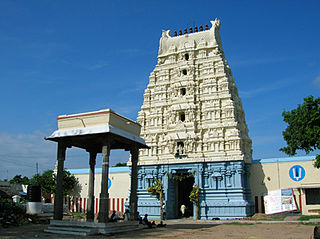
Sri Bhaktavatsala Perumal temple is a Hindu temple, located at Thirunindravur, a western suburb of Chennai, India. It is dedicated to the Hindu deity Vishnu. Constructed in the Dravidian style of architecture, the temple is glorified in the Naalayira Divya Prabandham, the early medieval Tamil canon of the Alvar saints from the 6th–9th centuries CE. It is one of the 108 Divya Desams dedicated to Vishnu, who is worshipped as Bhaktavatsala Perumal and his consort Lakshmi as Ennai Petra Thayar.

Tirukoilur also spelt as Tirukkoyilur or Tirukovilur is a city and the headquarters of Tirukoilur taluk in Kallakurichi District, Tamil Nadu, India. The town is located on the southern bank of Thenpennai River and famous for the Ulagalantha Perumal Temple, the Veerateeswarar Temple and the Kabilar Kundru. Tirukoilur is located on the highway connecting cities of Tiruvannamalai and Vellore with Southern Tamil Nadu. The town is served by Tirukoilur railway station.
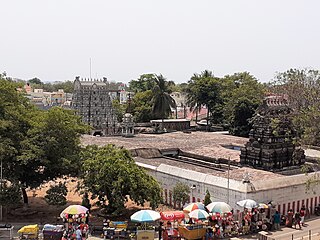
Sthalasayana Perumal Temple is at Mahabalipuram. Constructed in the Dravidian style of architecture, the temple is glorified in the Naalayira Divya Prabandham, the early medieval Tamil canon of the Alvar saints from the 6th–9th centuries CE. It is one of the 108 Divya Desam dedicated to Vishnu, who is worshipped as Sthalasayana Perumal and his consort Lakshmi as Nilamangai Thayar. The temple is believed to have been built by the Pallavas, with later contributions from the Medieval Cholas, Vijayanagara kings, and Madurai Nayaks.

The Pundarikakshan Perumal Temple or Thiruvellarai Temple in Thiruvellarai,a a village in the outskirts of Tiruchirappalli in the South Indian state of Tamil Nadu, is dedicated to the Hindu god Vishnu. Constructed in the Dravidian style of architecture, the temple is glorified in the Naalayira Divya Prabandham, the early medieval Tamil canon of the Alvar saints from the 6th–9th centuries CE. It is one of the 108 Divya Desams dedicated to Vishnu, who is worshipped as Pundarikakshan and his consort Lakshmi as Pankajavalli.
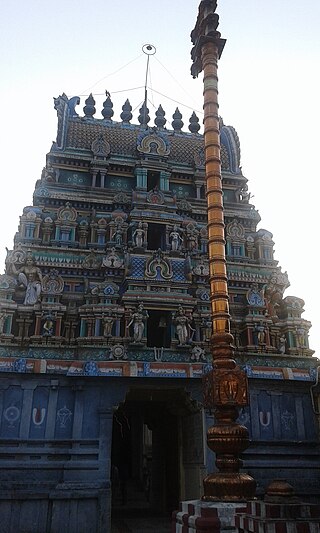
The Devaadi Raja Perumal temple in Therazhundur, a village in Mayiladuthurai district of the South Indian state of Tamil Nadu, is dedicated to the Hindu god Vishnu. Constructed in the Dravidian style of architecture, the temple is glorified in the Naalayira Divya Prabandham, the early medieval Tamil canon of the Alvar saints from the 6th–9th centuries CE. It is one of the 108 Divya Desams dedicated to Vishnu, who is worshipped as Amaruviappan, and his consort Lakshmi as Sengamalavalli Thayar. The original structure of the temple was built by the Karikala Chola during the 1st century CE, with later additions from the Cholas during the 11th century.

Tiruvekkaa Temple or Yathothkari Perumal Temple is a Hindu temple located in Kanchipuram in the South Indian state of Tamil Nadu and dedicated to the Hindu god Vishnu. Constructed in the Dravidian style of architecture, the temple is glorified in the Naalayira Divya Prabandham, the early medieval Tamil canon of the Alvar saints from the 6th–9th centuries CE. It is one of the 108 Divya Desams dedicated to Vishnu, who is worshipped as Yathothkari Perumal, and his consort Lakshmi as Komalavalli.

The Deepaprakasa Perumal Temple, also referred to as Tiruththanka, and Tooppul, is located in Kanchipuram in the South Indian state of Tamil Nadu, is a temple dedicated to the Hindu god Vishnu. Constructed in the Dravidian style of architecture, the temple is glorified in the Naalayira Divya Prabandham, the early medieval Tamil canon of the Alvar saints from the 6th–9th centuries CE. It is one of the 108 Divya Desams dedicated to Vishnu, who is worshipped as Deepaprakasar, and his consort Lakshmi as Maragathavalli.

Thiru Anbil, or Sundararaja Perumal Temple, in Anbil, a village in the outskirts of Tiruchirappalli in the South Indian state of Tamil Nadu, is dedicated to the Hindu god Vishnu. Constructed in the Dravidian style of architecture, the temple is glorified in the Naalayira Divya Prabandham, the early medieval Tamil canon of the Alvar saints from the 6th–9th centuries CE. It is one of the 108 Divya Desams dedicated to Vishnu, who is worshipped as Sundararajan and his consort Lakshmi as Sundaravalli.

Ulagalandha Perumal Temple is a temple dedicated to Vishnu located in Kanchipuram, Tamil Nadu, India. Constructed in the Dravidian style of architecture, the temple is glorified in the Naalayira Divya Prabandham, the early medieval Tamil canon of the Alvar saints from the 6th through 9th centuries CE. It is one of the 108 Divya Desams dedicated to Vishnu, who is worshipped as Ulagalantha Perumal, and his consort Lakshmi as Amuthavalli. The temple is believed to have been built by the Pallavas, with later contributions from the medieval Cholas, Vijayanagara kings, and Madurai Nayaks.
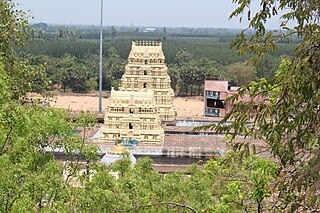
Devanatha Hemabhujavalli Temple (Thiruvaheendrapuram) is a Hindu temple in Thiruvanthipuram, a village in the outskirts of Cuddalore in the South Indian state of Tamil Nadu, dedicated to the god Vishnu and goddess Lakshmi. Constructed in the Dravidian style of architecture, the temple is glorified in the Nalayira Divya Prabandham, the early medieval Tamil canon of the Alvar saints from the 6th–9th centuries CE. It is one of the 108 Divya Desams dedicated to Vishnu, who is worshipped as Devanatha and Lakshmi as Hemabhujavalli. Though the presiding deity is Devanatha and Hemabhujavalli, the temple is known for Hayagriva, the ninth avatara of Vishnu in the Dashavatara of Vishnu and a god of knowledge. The temple is the only historical temple in South India to have a shrine of Hayagriva on hilltop.

Pandavatutar Perumal Temple or Thirupadagam located in Kanchipuram in the South Indian state of Tamil Nadu, is dedicated to the Hindu god Krishna, an avatar of the god Vishnu. Constructed in the Dravidian style of architecture, the temple is extolled in the Nalayira Divya Prabandham, the early medieval Tamil canon of the Alvar saints from the 6th–9th centuries CE. It is one of the 108 Divya Desams dedicated to Vishnu, who is worshipped as Pandava Tutar Perumal (Krishna) and his consort Lakshmi (Rukmini.)

Kazheesirama Vinnagaram or Tadalan Kovil or Tiruvikrama (trivikara) Perumal Temple is a temple dedicated to Vishnu located in Sirkazhi, Tamil Nadu, India. Constructed in the Dravidian style of architecture, the temple is glorified in the Nalayira Divya Prabandham, the early medieval Tamil canon of the Alvar saints from the 6th–9th centuries CE. It is one of the 108 Divya Desam dedicated to Vishnu, who is worshipped as Trivikrama and his consort Lakshmi as Loganayagi. The temple is believed to have been built by Cholas, with later contributions from Medieval Cholas, Vijayanagara kings, and Madurai Nayaks.

The Saranathan Temple in Thirucherai, a village on the outskirts of Kumbakonam in the South Indian state of Tamil Nadu, is dedicated to the Hindu god Vishnu. The temple is glorified in the Nalayira Divya Prabandham, the early medieval Tamil canon of the Alvar saints from the 6th–9th centuries CE. It is one of the 108 Divya Desams dedicated to Vishnu, who is worshipped as Saranathan and his consort Lakshmi as Saranayaki. It is believed that Saranathan appeared for Kaveri, the river goddess, who performed penance at this place.
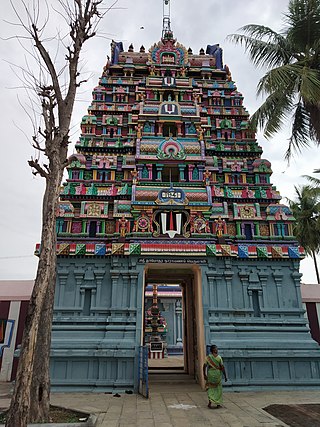
The Loganatha Perumal Temple is a Hindu temple dedicated to Vishnu located 2 km away from Sikkal, Tamil Nadu, India on the Tiruvarur-Nagapatnam highway. Constructed in the Dravidian style of architecture, the temple is glorified in the Nalayira Divya Prabandham, the early medieval Tamil canon of the Alvar saints from the 6th–9th centuries CE. It is one of the 108 Divya Desams dedicated to Vishnu, who is worshiped as Loganatha Perumal and his consort Lakshmi as Loganayagi.

The Gajendra Varadha Perumal Temple in Thirukkavithalam, a village in the outskirts of Papanasam in the South Indian state of Tamil Nadu, is dedicated to the Hindu god Vishnu. Constructed in the Dravidian style of architecture, the temple is glorified in the Nalayira Divya Prabandham, the early medieval Tamil canon of the Alvar saints from the 6th–9th centuries CE. It is one of the 108 Divya Desams dedicated to Vishnu, who is worshipped as Gajendra Varadha Perumal and his consort Lakshmi as Ramamanivalli. The temple is one of the five Pancha-Kannan temples, where Krishna, an avatar of Vishnu is given prominence over the presiding deity.
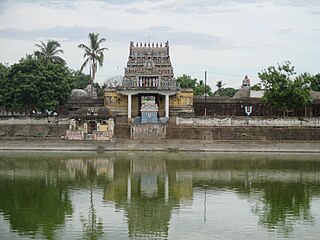
The Bhaktavatsala Perumal Temple is a temple dedicated to Hindu god Vishnu, located in Thirukannamangai, a village in Tiruvarur district in the South Indian state of Tamil Nadu. Constructed in Dravidian style of architecture, the temple is glorified in the Nalayira Divya Prabandham, the early medieval Tamil canon of the Alvar saints from the 6th–9th centuries CE. It is counted as one among the 108 Divya Desams dedicated to Vishnu. Vishnu is worshipped as Bhaktavatsala Perumal and his consort Lakshmi as Kannamangai Nayagi.
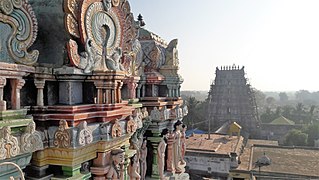
Sowmyanarayana Perumal Temple is an ancient temple located in Thirukoshtiyur, a village in the South Indian state of Tamil Nadu, dedicated to the Hindu god Vishnu. Constructed in the Dravidian style of architecture, the temple is glorified in the Nalayira Divya Prabandham, the early medieval Tamil canon of the Alvar saints from the 6th–9th centuries CE. It is one of the 108 Divya Desams dedicated to Vishnu, who is worshipped as Sowmyanarayana Perumal and his consort Lakshmi as Thirumamagal. The temple is known as the place where Ramanuja, the expounder of Vishishtadvaita philosophy preached the holy ashtakshara "Om Namo Narayanaya" to all people, irrespective of their varna.
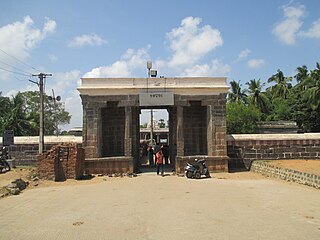
Nithyakalayana Perumal temple in Thiruvidandai, a village in Chennai, Chengalpattu district of the South Indian state of Tamil Nadu, is dedicated to Varaha, the boar avatar of the Hindu god Vishnu. Constructed in the Tamil style of architecture, the temple is glorified in the Naalayira Divya Prabandham, the early medieval Tamil canon of the Alvar saints from the 6th–9th centuries CE. It is one of the 108 Divya Desams dedicated to Vishnu, who is worshipped as Nithyakalayana Perumal (Varaha) and his consort Lakshmi as Komalavalli Thayar. The original structure of the temple was built by the Pallavas during the 7th century CE, with later additions from the Cholas during the 11th century.




























